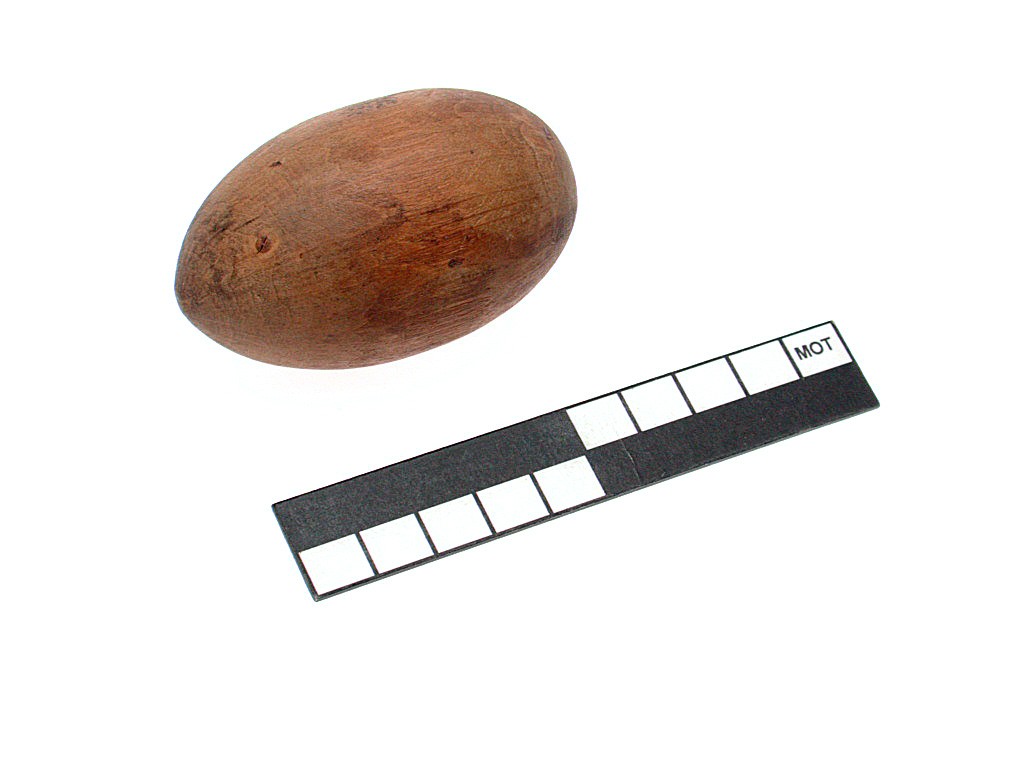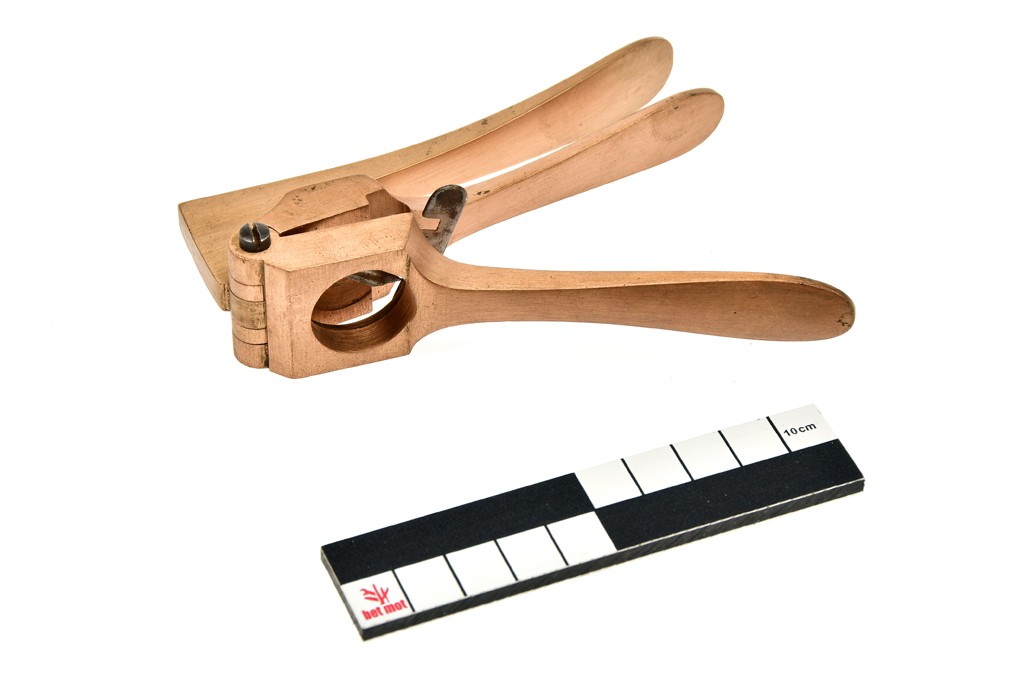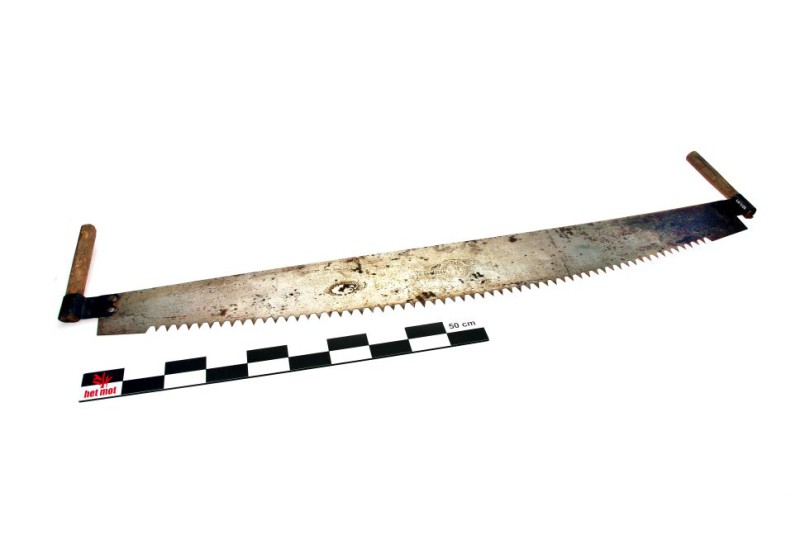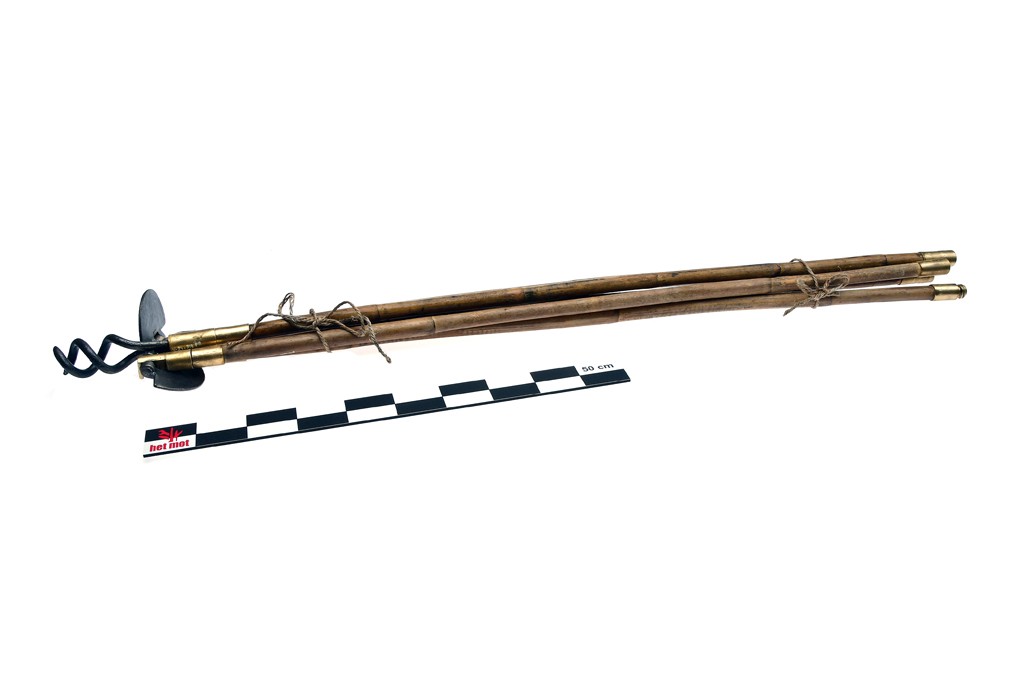ID-DOC: general search
Here you can enter a general keyword and perform a general search.
??? What are these question marks doing here? These represent tools which we know by a Dutch or French name, but who's English name is yet unknown. Suggestions are always welcome!
If you cannot find a certain tool, or if you experience other problems with this page, please let us know at info@mot.be.
Search for: tool
Showing search results 451 - 500
1,492 results found

Curling iron
Monoxile stick tapering towards the end with a straight handle (approx. 30
cm) - distinguishable from the glove stick - intended for applying
corkscrew curls in the hair. After a first shaping of the lock with a
curling iron, it is curled and turned around the curling stick. The strand
twisted around the stick is brushed, from top to bottom and in the same
direction. When the curling stick is pulled out of the hair, the lock is
turned into a pipe curl. [MOT]

Currycomb
A currycomb is used to clean a horse or cow. The coarse dried dirt can be
gently scraped off the skin with it. The currycomb also opens the sweat
holes of the horse skin (1). The currycomb consists of a metal plate with
two to eight rows of short (approx. 3 mm) blunt teeth and a handle (approx.
10 cm) or strap for putting the hand through. The working part can have
different shapes. For example, it can consist of serrated plates that are
mounted parallel in a wooden or to an iron plate or frame (approx. 15 by 10
cm). It can also be a semi-cylindrical plate, where both sides are
serrated, or consist of different serrated rings that are mounted on a
plate or crossbar. Nowadays a rubber disc with studs is also used. The
currycomb can be combined with a mane comb, the blunt teeth of which are
much longer. Distinguished from the soft horse brush, used to clean and
smooth the horse's short hair. [MOT]

Curve plane
This text can only be consulted in Dutch
<https://www.mot.be/resource/Tool/curve-plane?lang=nl>

Curved knife
The curved knife of a basket maker is very similar to the pruning knife but
with a fixed and usually shorter (5-8 cm) blade. It is used just like the
pruning knife by the basketmaker to cut a twig (1) (see also pruning
shears); by the plumber and roofer to cut lead sheets (2); by the saddler
to cut out leather. A curved knife is also used for cutting oilcloths. See
also the linocutter and pocket knife. [MOT] (1) A basket maker's cleaver
cut in the suture of the curved knife is exceptional (BOUCARD: 81). (2)
Also called plumber's knife or lead knife (VAN HOUCKE 1901-1902: 450). It
is usually a folding knife.

Cutting board
Vegetables are finely chopped on a chopping board with a chopping knife. It
consists of a rectangular or trapezoidal shelf with three raised edges, so
that the cut food stays in place. In the modern kitchen, this chopping
board has often been replaced by a chopping board without raised edges. See
also chopping block. [MOT]

Cutting gauge
This text can only be consulted in Dutch
<https://www.mot.be/resource/Tool/381?lang=nl>

Cutting mould (square paving-tile maker)
This text can only be consulted in Dutch
<https://www.mot.be/resource/Tool/cutting-mould-square-paving-tile-maker?lang=nl>

Daisymaker
This text can only be consulted in Dutch
<https://www.mot.be/resource/Tool/daisymaker?lang=nl>

Dancing master calliper
This text can only be consulted in Dutch

Darner
This text can only be consulted in Dutch

Darning hoop
This text can only be consulted in Dutch
<https://www.mot.be/resource/Tool/darning-hoop?lang=nl>

Darning tool
This text can only be consulted in Dutch
<https://www.mot.be/resource/Tool/1180?lang=nl>

Decapping/capping tool
This text can only be consulted in Dutch

Decorator's tongs
Decorator's tongs are a composite tool to be able to perform as many
operations as possible with one tool. These pliers consist of carpenter's
pincers, fitter's pliers, wire cutting pliers, a hammer, an axe, a crow bar
and a screwdriver. [MOT]

Detonating cord crimper
This text can only be consulted in Dutch
<https://www.mot.be/resource/Tool/detonating-cord-crimper?lang=nl>

Diamond cleaver
The cleaver splits the diamond crystal with this knife. It is made of steel
and can be of different sizes and weights. It is rectangular in shape,
approx. 3 by 10 cm, and weighs approx. 70 gr. The blade should not be sharp
as it should split and not cut. Before splitting, a cut is made in the
stone with a sharp diamond or laser. The notch must be V-shaped. Then the
cleaver is placed against one of the sloping sides of the kerf. With the
splitter hammer, an iron bar of 20 to 30 cm or a wooden hammer, you give a
short blow to the cleaver to divide the stone into two pieces. The aim is
to give the rough diamond a good shape, so that it can then be sawn and /
or cut. [MOT]

Diamond mortar
This text can only be consulted in Dutch
<https://www.mot.be/resource/Tool/diamond-mortar?lang=nl>

Diamond sieve
This text can only be consulted in Dutch
<https://www.mot.be/resource/Tool/diamond-sieve?lang=nl>

Dibble
This text can only be consulted in Dutch
<https://www.mot.be/resource/Tool/dibble?lang=nl>

Digging fork
A digging fork is used to work or crumble stony or strongly cohesive (clay)
soil and to dig in manure. In the (vegetable) garden, unlike the garden
spade, the roots of the plant are less damaged when transplanting with the
digging fork. For the same reason, the gardener also prefers this tool for
sticking out creepers and shrubs. A slightly wider and longer fork is used
as a potato lifting fork. See also the little digging fork. [MOT]

Dike auger
This text can only be consulted in Dutch
<https://www.mot.be/resource/Tool/dike-auger?lang=nl>

Dinging hammer
Hammer (approx. 350-500 gr) that is used to dent the body of a car. It has
a relatively long (approx. 15-20 cm), narrow cylindrical head of which one
end forms a widened circular shape. The other end can be tapered, spherical
or square. See also the body file.

Disgorger
This text can only be consulted in Dutch
<https://www.mot.be/resource/Tool/disgorger?lang=nl>

Dish clamp
This text can only be consulted in Dutch
<https://www.mot.be/resource/Tool/1165?lang=nl>

Divers' knife
This text can only be consulted in Dutch
<https://www.mot.be/resource/Tool/divers-knife?lang=nl>

Docking-iron
Hand tool used by the shoeing-smith to trim the tail beyond the tailbone of
draft horses (1). It is tang-shaped with relatively long (approx. 30-40 cm)
arms, with or without wooden handles. One jaw is cut in a U-shape and is
hollow so that the cutting blade fits on the other jaw; exceptionally it is
made of wood (2). The tail is cut just after the sacrum so that it cannot
grow back. The wound is burned out with a cauterizing iron. [MOT] (1) N.L.I
.: s.v. brûle-queue, reports that the horse's tail was cut off after it
suffered a stroke. (2) STOQUART: 23.

Dog dresser's knife
This text can only be consulted in Dutch
<https://www.mot.be/resource/Tool/dog-dressers-knife?lang=nl>

Dog's and sheep trimmer
This text can only be consulted in Dutch
<https://www.mot.be/resource/Tool/dogs-and-sheep-trimmer?lang=nl>

Double-edged crosscutting and ripping saw (Japanese)
This text can only be consulted in Dutch
<https://www.mot.be/resource/Tool/double-edged-crosscutting-and-ripping-saw-japanese?lang=nl>

Double-handed crosscut saw
The double-handed crosscut saw is a large, rigid-bladed saw used by two men
(1) to cut logs and beams across and fell trees. She cuts in both
directions. This saw consists of a long toothed blade (1.30-2 m) (2) often
wider in the middle (12-17 cm), and at the ends two straight handles (3) of
approx. 50 cm. There are now crosscut saws saws with adjustable handles,
which can be placed vertically or horizontally. The log to be cut is rolled
onto a crosspiece and the sawyers pull (never push) the saw in turn. [MOT]
(1) In softwood, some craftsmen could handle this saw alone. (2) BOERHAVE
BEEKMAN 1949/5: 408, fig. 11.09 shows a tree with a circumference of 13.19
m that has been cut down with two crosscut saws that are welded together in
line. (3) The crosscut saw with closed handles (eg BISTON-BOUTEREAU-HANUS:
247) appears to be rare.

Dough grater
This text can only be consulted in Dutch
<https://www.mot.be/resource/Tool/dough-grater?lang=nl>

Dough scraper
Hand tool with which the last bits of dough are scraped from the baking
trough. It is a metal tool with a wide-flared or square blade that is
perpendicular to the metal handle (1). See also the dough grater. [MOT] (1)
In Great Britain you can also find dough scrapers with a tang or with a
socket and wooden handle.

Dowel plate
The dowel plate is to be distinguished from the nail header.This text can
only be consulted in Dutch.

Drag-net
This text can only be consulted in Dutch

Drain auger
This text can only be consulted in Dutch
<https://www.mot.be/resource/Tool/drain-auger?lang=nl>

Drain ladle
To lay drainage pipes, a trench is first dug one or two stitches deep (and
approx. 50-60 cm wide) with the garden spade and the spade. After the loose
soil that the spade has not been able to absorb has been removed with a
masonry shovel, also with a kind of flat drain laddle, the trench is
brought to depth with the narrow drain spade. Finally, with the drain
laddle, the bottom of the trench is finished very accurately and at the
required slope, so that the pipes can be placed on it (see pipe layer); the
worker is standing next to the slot. [MOT]

Drain rods
This text can only be consulted in Dutch
<https://www.mot.be/resource/Tool/drain-rods?lang=nl>

Drain scoop
This text can only be consulted in Dutch
<https://www.mot.be/resource/Tool/kolkschep?lang=nl>

Draw bore pin
The draw bore pin serves to pull together heavy mortise and tenon joints.
It is an iron cone-shaped bar of about 20-30 cm on which a wing with a hole
is forged. More technical information on this page in dutch. See also the
peg of emergency. [MOT]

Drawing awl
A drawing awl is an approx. 30-40 cm long awl with a hole in the tip,
through which a cord can be inserted. The harness maker, saddler, mattress
maker and seat maker use this hand tool when sewing thick objects.
According to the Osborne catalog, the butcher used a drawing awl to bind
ham (1). [MOT] (1) OSBORNE: 49. The butcher's tool is called ham stringer.

Drawing plane
This text can only be consulted in Dutch
<https://www.mot.be/resource/Tool/drawing-plane?lang=nl>

Dressmaker's chalk
Chalk in the shape of a flat square (from 5 by 5 cm; thickness approx. 0.8
cm) block to properly mark fits. It comes in different colors (white,
yellow, red and blue), does not rub off on the hands and can be easily
tapped.Sometimes the dressmaker's chalk is put in a chalk holder, with
sharp edge to sharpen the chalk (1). [MOT](1) See MIDGLEY & LAWTHER: 280.

Drift (blacksmith)
This text can only be consulted in Dutch
<https://www.mot.be/resource/Tool/drift-blacksmith?lang=nl>

Drill saw
This text can only be consulted in Dutch
<https://www.mot.be/resource/Tool/drill-saw?lang=nl>

Drum sieve
This text can only be consulted in Dutch
<https://www.mot.be/resource/Tool/drum-sieve?lang=nl>

Dumbbell spanner
This text can only be consulted in Dutch
<https://www.mot.be/resource/Tool/dumbbell-spanner?lang=nl>

Dung axe
Axe with high (approx. 30 cm), heavy and thick (approx. 4 mm) iron blade
and arc-shaped blade, which is connected to a wooden handle (approx. 90
cm). The dung axe is used to cut through the tamped manure - in the potting
shed or outside - in contrast to the flauchter spade that is used for
cutting. See also turf cutting axe. [MOT

Dung fork
This text can only be consulted in Dutch
<https://www.mot.be/resource/Tool/dung-fork?lang=nl>

Dung hoe
This text can only be consulted in Dutch
<https://www.mot.be/resource/Tool/dung-hoe?lang=nl>

Ear spoon
This text can only be consulted in Dutch
<https://www.mot.be/resource/Tool/1172?lang=nl>
